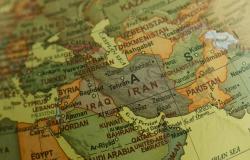Whither the Middle East in Trump's Tripolar World?

Donald Trump’s dismantling of the US-led international order in favour of ‘great power’ spheres of influence has profound implications for the Middle East; but, even if it materialises, it may not bring peace and stability to the region.
Note: This column is a (lightly edited) version of a Newsletter published by ‘Arab Digest’ on 21 March. For ‘Global Policy’, it follows on from the author’s 12 March column ‘Trump-ism and East Asia’.
“What is not clear…is whether Trump’s vision of an ultimately more stable international order with clearly defined spheres of influence for the great powers of the day – the US, China and possibly Russia – will emerge, let alone whether such an outcome would be desirable.”
Stefan Wolff, The Conversation, 17 January 2025
As I recalled at the start of my 12 March column, the geopolitical premise of George Orwell’s ‘Nineteen Eighty-Four’ is that the world has divided into three totalitarian superstates. For now at least, one should be cautious about the extent to which one draws parallels between this scenario and US foreign policy under Donald Trump. Nevertheless, having referenced China and Russia in particular — together with Narendra Modi’s India and Recep Tayyip Erdoğan’s Turkey) — Michael Kimmage argued in ‘Foreign Affairs’ on 25 February as follows:
“Trump and comparable tribunes of national greatness are now setting the global agenda. They are self-styled strongmen who place little stock in rules-based systems, alliances, or multinational forums.”
My sole point of variance with Mr Kimmage is that I would add Saudi Arabia’s Crown Prince Mohammed bin Salman to his list of “self-styled strongmen” admired by Mr Trump. However, what this means either for Saudi Arabia or for the wider Middle East is far from clear. Indeed, Israel/Gaza and Iran aside, the region has hardly featured in Mr Trump’s public statements. Even Saudi Arabia has only won mention in the form of a call for Opec+ to pump more oil (coupled, paradoxically, with a bid for more Saudi investment in the US) and as the host of what increasingly appears to be the US/Russia carve up of Ukraine.
Given what Mr Trump’s attention seems generally to mean — notably tariffs — countries in the region are probably glad for the lack of it. However, it would be very unwise to conclude that such neglect is in any way benign. Notably (and, again, as I explained in the 12 March column), China aside, to date much the same degree of Trump-ian disinterest has befallen East Asia. In consequence, with the US President clearly focused on building up power in the western hemisphere — think Canada, Greenland and Panama — the FT’s Gideon Rachman (writing on 10 March) is far from alone in believing that, as part of his sought-after ‘grand bargain’ with Beijing, he would surrender US influence in the Indo-Pacific region despite it now being “the heart of the global economy”. Furthermore, Mr Rachman is correct to Mr Trump “has zero intention of tangling with a scary-looking Russia” as underlined by the White House’s own account of the latter’s 18 March call with Vladimir Putin.
This being said, we can assume that Mr Trump will continue to offer staunch support to Israel, including trying to nudge Riyadh towards signing an Abraham Accord, not least with an eye to the white evangelicals who make up a large proportion of the MAGA faithful. Consider, for example, the alacrity with which Washington backed Israel’s 18 March strikes on Gaza despite being in supposedly ongoing talks with Hamas. Furthermore, last week’s strikes against the Houthi, although purportedly to protect shipping, serve as a clear warning to Iran that, especially if Tehran continues to refuse to come to the table, the US may yet launch joint strikes with Israel against Iranian nuclear installations.
To be fair to Mr Trump, he is hardly the first US president to want to get out of the Middle East. However, there is a world of difference between, notably, Barack Obama’s strategically determined ‘pivot to Asia’ and simply abandoning the region to be absorbed into the sphere of influence of another ‘great power’, be it Russia or, more likely, China.
Ever since China first established the Shanghai Cooperation Organisation (SCO) in 2001, I have argued that Beijing clearly understands the principles of Mackinder’s Heartland Theory (1904) which defined the area east of the Volga, south of the Arctic, west of the Yangtze, and north of the Himalayas as the ‘geographical pivot of history’ at the centre of the Africa-Eurasia ‘world island’. The much more ambitious Belt & Road Initiative (BRI), formally announced by Xi Jinping during an official visit to Kazakhstan (itself at the heart of the ‘heartland’), has further consolidated China’s ties with the mainly former Soviet bloc countries, which make up much of the southern part of Mackinder’s ‘pivot area’, and more widely. Latterly, the 2024 BRICS enlargement, which swept in Egypt, Iran and the UAE inter alia (with Saudi Arabia still considering whether to accept an invitation), seems similarly aimed.
Mackinder did not, in fact, include the Gulf region in his heartland (it lies in his ‘inner crescent’). But it is included in the overlapping Intermediate Region model postulated seven decades later by Nicolas Kitsikis, a close associated of both Mao Zedong and Deng Xiaoping. One way or the other, and especially given its dependence (which it does not share with the US) on oil and gas from the region, it is extremely likely that, if/when the US steps back, China will look to pull the Gulf states as a whole into its sphere of influence.
However, this scenario is unlikely to mark the end of the story. Writing about declining relative and absolute US power in Asia in May 2024, the Lowy Institute’s Sam Roggeveen forecast what he referred to as a ‘multipolar regional order’ where China would be the leader but…. Adapting the relevant paragraph of his essay to the Middle East, it would read as follows:
But whether China becomes the dominant power is still unsettled and is something that all the countries of the region can have a role in deciding. For America’s allies and partners (notably Israel), the comfort of post-Cold War US dominance is over, and they cannot bring it back. But that doesn’t mean China will be the new hegemon. However, we may see the slow development of competing spheres of influence, geographic sub-regions in which one regional ‘great power’ dominates and others do not interfere.
Israel (backed by the US), Saudi Arabia and Turkey are clearly all candidates to assume such a role; Iran too, perhaps, depending on how events unfold in the more or less immediate future. However, and particularly given the number of militarised non-state actors in the region, even if such a scenario were to emerge it is far from certain that Mr Trump’s vision of “an ultimately more stable international order”, as described above by Stefan Wolff, would bring with it peace and stability to the Middle East.
Alastair Newton, an alumnus of the LSE, is a professional political analyst who was based in the City of London from 2005 to 2015. As such, he sought to anticipate, analyse and explain political and geopolitical events worldwide which may impact on financial markets. In addition to regular commentary on current political “issues” he is also co-author of major studies on China, India, Indonesia, Israel/Iran and North Korea.
Photo by Lara Jameson


